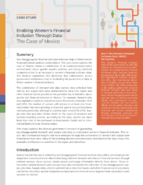Enabling Women’s Financial Inclusion Through Data: The Case of Mexico
Date issued
Feb 2019
Subject
Financial Inclusion;
Gender-Based Violence;
Gender Segregation
JEL code
N46 - Latin America • Caribbean
Country
Mexico
Category
Catalogs and Brochures
Sex-disaggregated financial inclusion data can help to inform better financial inclusion policies and products. This case study explores the case of Mexico, where a combination of an evidence-based policy environment, robust gender equality policies, and strong statistical competence led to an increase in women’s financial inclusion data. The Mexican experience also illustrates that collaboration across government institutions is key to facilitating the production of data to inform women’s financial inclusion. The combination of demand-side data (survey data collected from clients) and supply-side data (administrative data from banks and other financial sector providers) has provided key information about gender and financial inclusion in Mexico. For example, demand-side data highlights trends on overall access in the country: between 2012 and 2018, the number of women with access to at least one financial product has been growing; and gender gaps in access have been narrowing nationally, although at a slower pace from 2015–2018. Supply-side data provides further detail on the types of products and services reaching women; according to this data, women are more likely than men to be customers in development banks and in commercial banks in lower income states. This study explores the Mexican government’s process of generating sex-disaggregated demand- and supply-side data to understand women’s financial inclusion. This report also summarizes insights that have emerged through the combination of demand and supply-side financial services data. Many of the enabling elements and processes described in this case study offer examples and lessons to countries in the region and elsewhere



